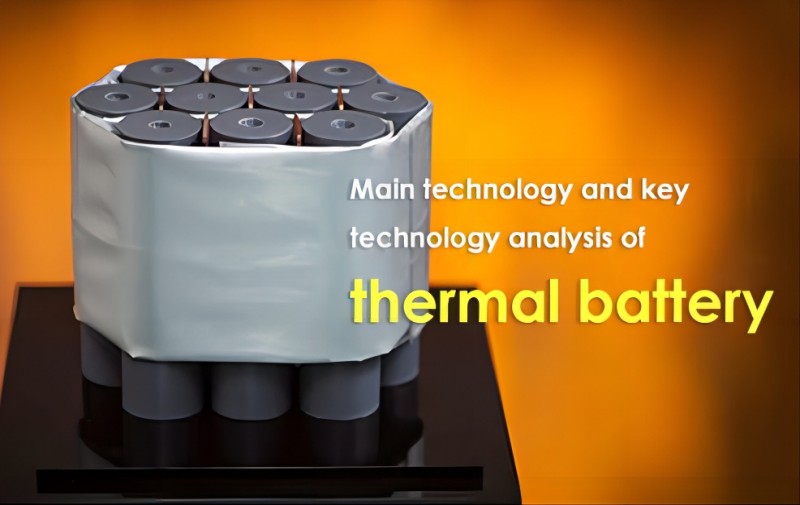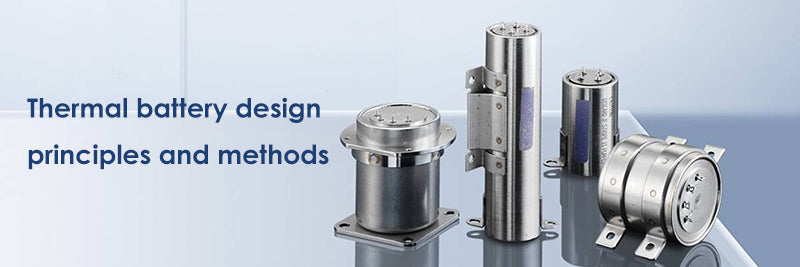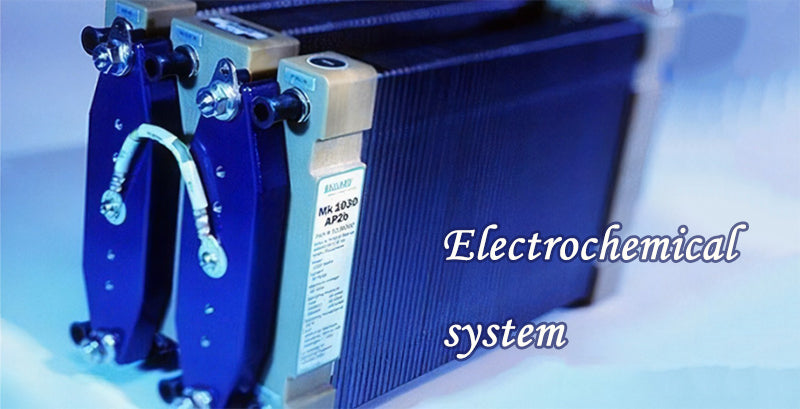
Main content:
- Thermal battery design principles and methods
- Thermal battery design
- Composition structure
- Activation method
- Electrochemical system
- Insulation material
- Structural design
- Key technology of thermal battery products
- Preparation and optimization of materials used in thermal battery
- Key technologies to reduce the surface temperature of thermal battery
- Key technologies of high-voltage thermal batteries
- Design of thermal battery conduction structure
- Design of high-performance and long-life thermal battery
Thermal battery is a kind of one-time reserve power supply, which has no energy output in reserve state. The heating element is ignited by the activation system to generate heat, so that the internal temperature of the thermal battery rises rapidly to about 500°C. The electrolyte melts into a liquid conductive state and outputs electric energy, and supplies power to the electrical equipment of the weapon system.
It has the advantages of short activation time, high output power, and work Wide temperature range (- 50℃~70℃), long storage time, strong resistance to mechanical environment, high reliability, etc., are widely used in nuclear weapons, missiles, torpedo artillery and other fields. The main technology of thermal battery design is based on design principles and methods, which are finally reflected in specific products, and products are composed of parts and chemical materials.
Thermal battery design principles and methods
The design principles of the thermal battery are: on the premise of meeting the requirements and technical indicators of the weapon system, fully refer to the mature technical process and structure; give full play to the guiding and guarantee role of standardization in the product development process; make full use of existing standard parts Common parts, low-cost design. The design method of the thermal battery is: (1) design and calculate the activation method, electrochemical system, electrical performance, heat preservation and structure according to the structural size performance indicators and service conditions, etc., to form a preliminary design scheme; (2) carry out mechanical Environmental adaptability and performance verification tests, and fine-tuning and optimization of structural process parameters; (3) Conduct assessment tests according to the assessment plan, and conduct demonstration and review of the design plan to determine the final design plan.Thermal battery design
Composition structure
The thermal battery is mainly composed of several parts such as the housing cover, terminal post, stack activation system, insulation material, etc. Among them, the shell and cover are processed by metal materials, which mainly accommodate the insulation material of the stack activation system. The stack is the core component of the thermal battery, and is mainly composed of several individual battery heaters, current collector insulation pads and insulating elements after assembly.
The electrochemical reactions are all carried out here and the activation system is used for the activation of the thermal battery. The insulation material is mainly used to delay the heat loss and maintain the temperature environment when the thermal battery is working.

Activation method
The activation methods of thermal batteries are divided into mechanical and electrical signals according to the signal characteristics. The mechanical activation method uses the overload impact method to generate force to ignite the pyrotechnics such as the cap, and ignites the heating plate to activate the thermal battery.
The advantage is that the overload of the system itself is used to generate the force, and the disadvantage is that it cannot be detected before use. The electrical signal activation method uses external electrical signals to make the electric ignition head ignite and ignite the heating plate to activate the thermal battery. It is characterized by simple structure, reliable function, and easy detection.
It is the first choice for thermal battery activation. In the design, an appropriate activation method can be selected according to the signal characteristics provided by the system. Figure 2 is a mechanical, electrical signal activated thermal battery product.
Electrochemical system
Currently commonly used cathode materials are FeS2, CoS2 and NiCl2. FeS2 material has the characteristics of long discharge time, large capacity and good stability, and is widely used in thermal batteries of different specifications. CoS2 material has good electrical conductivity and low polarization, and has higher thermal stability than FeS2, and is more suitable for high specific energy thermal batteries.

NiCl2 material is a high-potential material with strong load capacity and good thermal stability, suitable for high-power thermal batteries. Commonly used negative electrode materials include LiAl, LiSi and LiB alloys, etc. The properties of several alloy materials are shown in Table 2. LiSi alloy has mature production technology and excellent performance, and has been widely used in various types of thermal batteries.
LiB alloy is very suitable for thermal batteries with mass specific energy, high output power and long working life due to its high lithium content and large specific capacity. Thermal batteries require molten salt electrolytes with low density, low viscosity, low melting point and vapor pressure, high ion conductivity, small electronic conductivity, high decomposition voltage, no side effects on positive and negative electrodes, low dissolution and corrosion, good thermal stability, and good thermal stability for electrodes.
The material has good wettability. When choosing an electrochemical system, usually according to the different use requirements of the thermal battery, follow the principle of fusion and matching, and choose the appropriate electrolyte material. Currently commonly used electrolyte materials are LiCl-KCl, LiCl-LiBr-LiF and LiCl-LiBr-KBr.
At present, the heating agent commonly used in thermal batteries is heating paper made of Zr powder BaCrO4 and asbestos according to a certain ratio. It has the characteristics of mature technology, high sensitivity, and fast burning speed. The disadvantage is that it is sensitive to static electricity, poor in safety, and volatile after burning.
The other is iron heating powder made of active iron powder and potassium perchlorate in a certain proportion, which has the advantages of good mechanical strength, stable performance, easy molding and good electrical conductivity.
Insulation material
The thermal life of the thermal battery is the basic guarantee of the electrical life. Therefore, in the design process of the thermal battery, appropriate insulation materials should be selected to help reduce heat loss, prolong the working time of the thermal battery, and improve the utilization rate of electrode materials.Structural design
The single battery is an important part in the production of thermal batteries, and the pressing process is a key process. The relative humidity of the production environment is guaranteed to be below 3% (in actual production, it is strictly controlled below 1%); 100% insulation testing is carried out when the single battery is pressed , 100% inspection is also carried out during assembly and after assembly.
There are two commonly used structures: one is a three-layer sheet structure formed by multiple pressings of positive electrode powder, electrolyte powder, negative electrode powder and choke ring. The process is simple and it is suitable for the production of small-diameter single batteries. The other is a four-in-one structure in which iron heating powder, positive electrode powder, electrolyte powder and negative electrode powder are pressed and formed at one time. , different structures of single batteries can be selected according to specifications.

Key technology of thermal battery products
With the development of weapon systems, the demand for thermal batteries increases, and at the same time, the difficulty of design increases. To sum up its characteristics, the types of thermal batteries mainly include: high-performance long-life thermal battery, fast activation thermal battery, low surface temperature thermal battery, high voltage, power thermal battery, high specific energy thermal battery, high overload, high rotation thermal battery, pulse thermal battery and other types.
In the design of thermal batteries, analyze the technical indicators, classify them into thermal battery types, carry out design with targeted purposes, formulate key technologies, and then carry out research and development experiments based on theory and experience. The following is a comprehensive overview of the key technologies of thermal battery products, including the optimization of electrode materials, the preparation and rational matching of thermal insulation materials, the preparation of overload-resistant single batteries and the measures to reduce the surface temperature of combined thermal batteries, the unique design of anti-high voltage, anti-breakdown thermal battery stacks, etc.
Preparation and optimization of materials used in thermal battery
Due to poor electrical conductivity, large polarization, and poor temperature resistance of the positive electrode, thermal batteries produced by current technology have problems such as high decomposition of active materials and low utilization of effective capacity, mainly as follows:
- The active material decomposes
More and the effective capacity utilization rate is low. The decomposition and activation energy of pyrite (iron disulfide), the positive active material, is 227KJ/mol, which is a moderately stable substance. The decomposition temperature starts at 350°C. If it is left at 500°C for 20 minutes, the capacity loss will be as high as 62%. Therefore, no measures should be taken for the battery The active material of the active material decomposes more, and the effective capacity utilization rate is low.
- Poor electrical conductivity
Pyrite, the active material of the positive electrode, is a semiconductor material with poor electrical conductivity and high internal resistance when the battery is working. This not only causes poor load capacity, but also leads to thermal runaway, which brings safety hazards to the battery.
- Large polarization
Due to the poor contact of the positive active material pyrite particles and the poor wettability with the electrolyte, the electrode reaction contact point is small, the activity is low, the polarization is large, the voltage drop is large under the condition of high current operation, and the load capacity is poor.
The method used to solve the technical bottleneck: using a new type of positive electrode composition, through a special process optimization treatment, to prepare a low polarization positive electrode material, which can improve the electrical conductivity, wettability and reactivity of the positive electrode, thereby improving the utilization of active materials rate and output voltage stability.

Key technologies to reduce the surface temperature of thermal battery
The characteristic of the thermal battery is that the internal environment is in a high temperature state during operation, which can usually reach above 550°C, and the surface temperature of the thermal battery can reach as high as 250°C to 350°C through heat conduction. Since the main application of the thermal battery is to provide electrical energy to the missile system, excessive surface temperature will exceed the temperature tolerance range of the system.
Excessive surface temperature seriously affects the reliability and safety of electronic components on the bomb, thus limiting the application range of thermal batteries. In order to meet the development needs of new weapon systems, the metal foil-wrapped hollow skeleton heat insulation technology has been developed, which has achieved the technical level of reducing the surface temperature of high specific energy and long-term thermal batteries to less than 80 °C.
The airgel layer plays the role of thermal insulation. Hollow skeletal layers create convective cooling channels. The metal foil with high thermal conductivity can realize rapid heat exchange with the atmosphere, thereby reducing the surface temperature of the thermal battery.
Key technologies of high-voltage thermal batteries
As a supporting power source for ultra-high-speed weapons - thermal batteries, it has the characteristics of ultra-high current. At present, thermal batteries with output current up to 200A and voltage up to 500V have been successfully developed abroad.Design of thermal battery conduction structure
A new type of conduction connection structure is used inside the thermal battery. The guide bar and the silver-plated bare wire are welded together by brazing. The advantage of this structure is that the reliability of the internal electrical connection of the thermal battery is improved. The flexible connection can effectively prevent the thermal battery from being subjected to harsh mechanical environmental conditions.
The lower failure problem occurs, and the working reliability of the thermal battery is improved. The silver-plated bare wire has smaller internal resistance than the conventional lead wire at the time of high-current output, which reduces the consumption of output power. In order to reduce the current load of each terminal, multiple sets of terminals are designed on the top of the battery cover, which greatly reduces the ohmic polarization and heat generation when large current passes.
Epoxy structural parts are used to replace the traditional asbestos structure. On the one hand, this structure protects the damage and failure of the electric ignition head due to the change of closing pressure during battery assembly. The distance between the stacks strengthens the insulation and prevents the thermal battery from impacting the glass body of the guide column when it is working at high voltage and high current. Voltage vs current is sometimes quite different and you can click and read our article which detailedly tells the differences between them.

Design of high-performance and long-life thermal battery
The working life of thermal batteries can be seen from two aspects, one is electrical life and the other is thermal life. The electrical life is related to the battery capacity, and the thermal life is the time during which the temperature of the battery electrolyte remains above the melting point. The operating life of a thermal battery is fundamentally determined by the properties of the material itself.
The characteristics of thermal insulation materials, positive electrode fodder, electrolyte, negative electrode materials, etc. are the most important factors affecting the working life of thermal batteries, and are the internal factors that determine the working life of thermal batteries.
Related article: battery thermal management, flow battery manufacturers, potassium ion battery
















